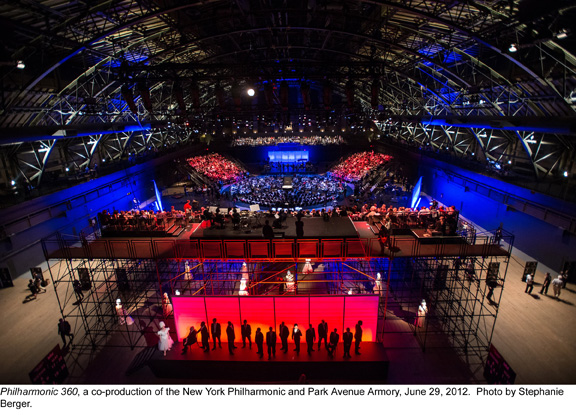
Entering the Park Avenue Armory for Philharmonic 360, a program of four distinct examples of what James M. Keller referred to as “spatial music,” the first thing I noticed were a selection of well-dressed men and women, seemingly frozen in place. It seemed an odd and striking touch, an indication that the evening’s program would be a stylized one. The music that followed ranged from Stockhausen’s Gruppen to the finale of Act I of Mozart’s Don Giovanni. And it was the first time I’d seen work, whether visual or musical, that made use of the Armory as a whole since last year’s performance of John Luther Adams’s Inuksuit.
The first half of the program left me with some concerns. Most of the musicians were arranged on three platforms, with other players placed throughout the Armory’s cavernous hall as befitted the needs of specific compositions; the audience sat between them. At the program’s best moments, the configuration worked brilliantly, with notes and moods passed from one group of musicians to the next, creating a powerful sense of the whole. At other moments, however, the configuration obscured certain aspects of the music being heard; from where i was sitting, for instance, some of the vocals in Don Giovanni were drowned out by the sound of horns.
The piece’s choreography fared better, finding the posed figures that had greeted the audience moving through the crowd; it was at times disorienting and at times thrilling, and the confrontation that closed the piece — located at the center of the Armory, in clear view of all — brought things together neatly. Still, at the end of the first half, with work from Boulez and Mozart out of the way, I found myself wondering what the second half might bring: was this evening more of a proof of concept, a sampler of what could be achieved with such a spatial approach? Or would it strike at something deeper?
The second half opened with Stockhausen’s Gruppen, which placed an orchestra and a conductor on each of the three platforms. It was here that the full potential of the arrangement of musicians was achieved: the piece allowed distinct motifs to develop on each of the three platforms, and yet a sort of continuity developed, a kind of musical relay, each group echoing its predecessor. There also seemed to be echoes of Mozart’s composition, creating a sense that what the audience witnessed was more than a simple sampler. At the end of Gruppen, the three conductors embraced, and a guy sitting down the row from me shouted, “Bravo!” repeatedly; it seemed entirely earned.
Charles Ives’s The Unanswered Question closed out the evening, the three orchestras and their three conductors in the same configurations as they’d been for the Stockhausen piece. It opened on a note of sustained peace, an elegant elegy with a starkly played horn melody traveling over drones. Slowly, dissonant notes emerged, maneuvering around the harmonies but never drowning them out. The title of Ives’s piece could have stood for the night as a whole: many of the pieces ended on ambiguous notes, and in choosing this as the conclusion, the Philharmonic achieved both a bold sense of progression and an ambiguous provocation.
Follow Vol. 1 Brooklyn on Twitter, Facebook, Google + and our Tumblr.
